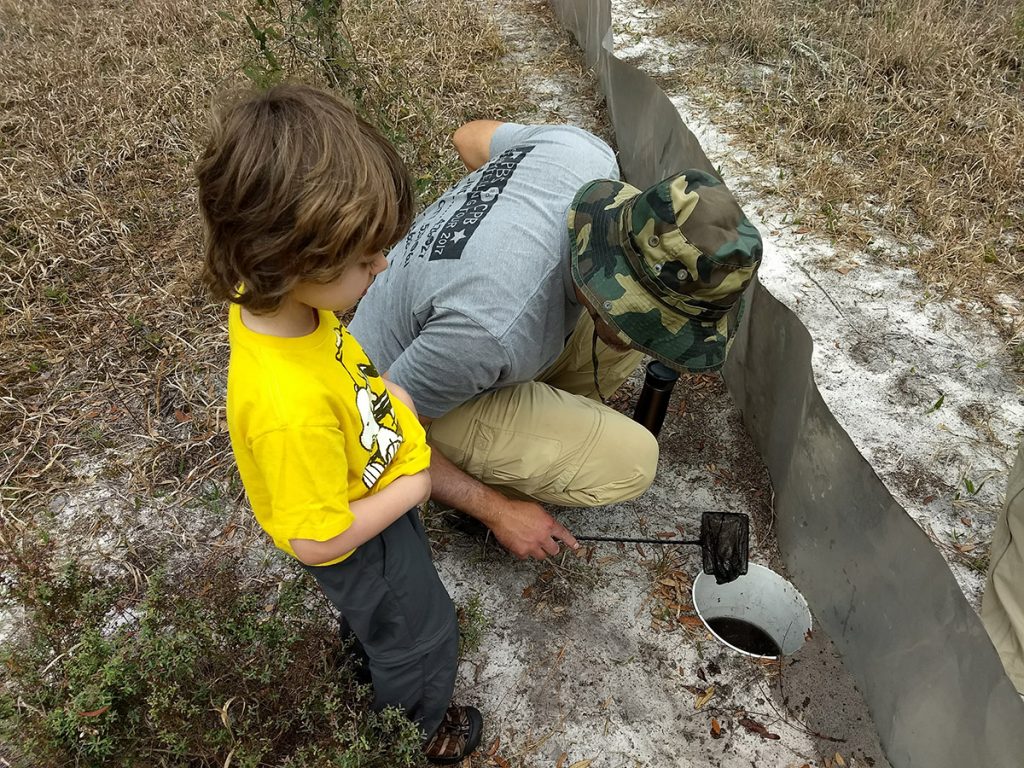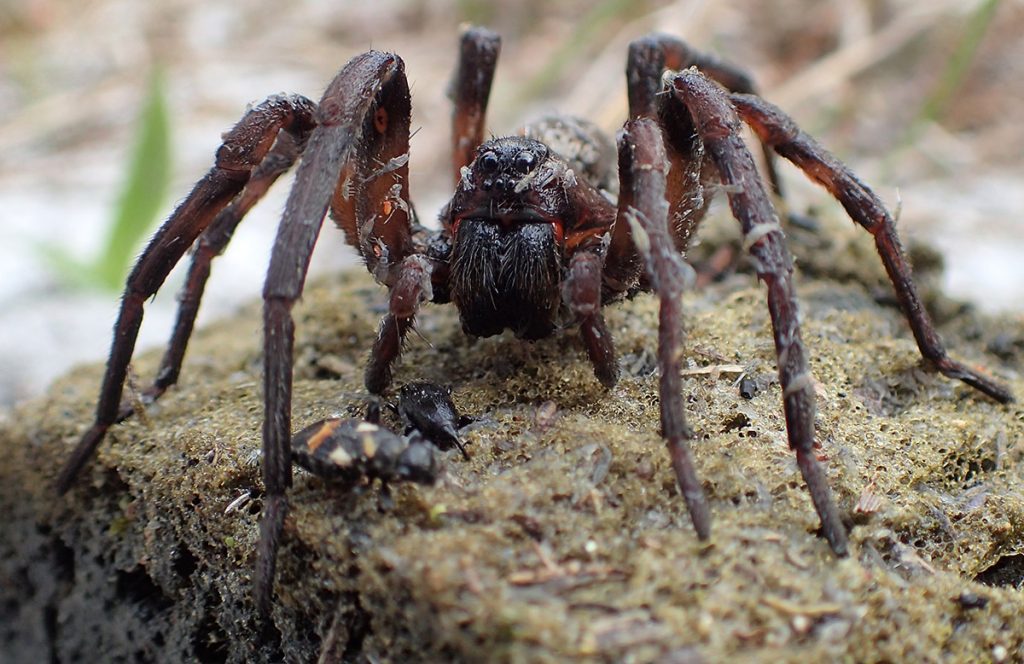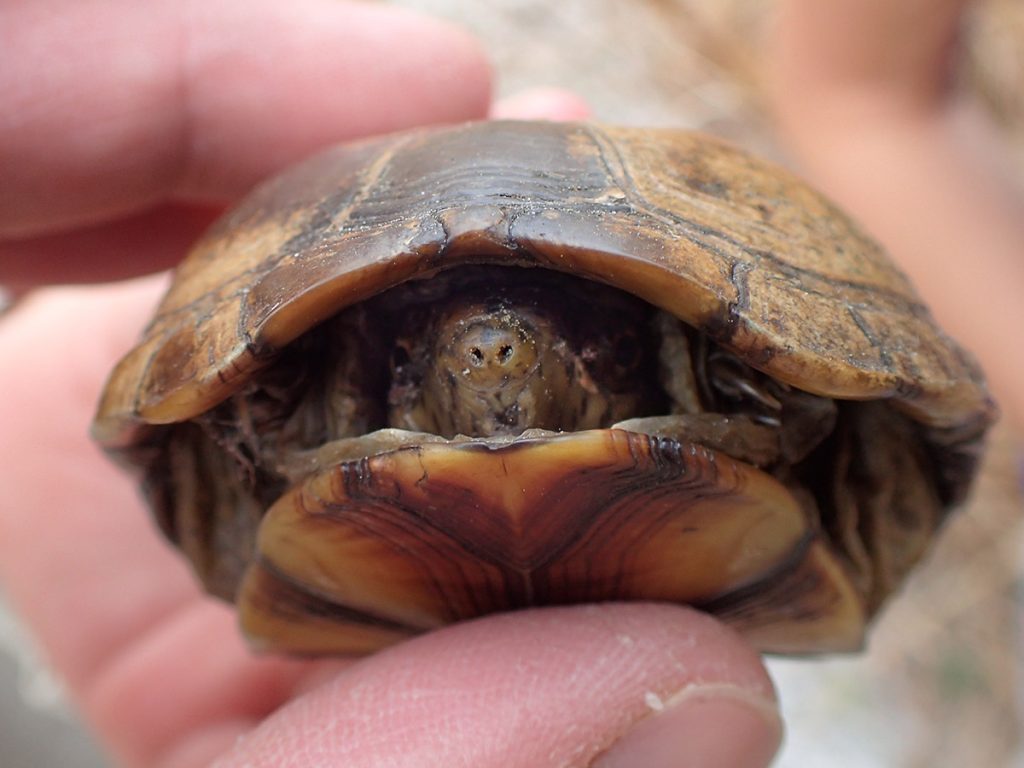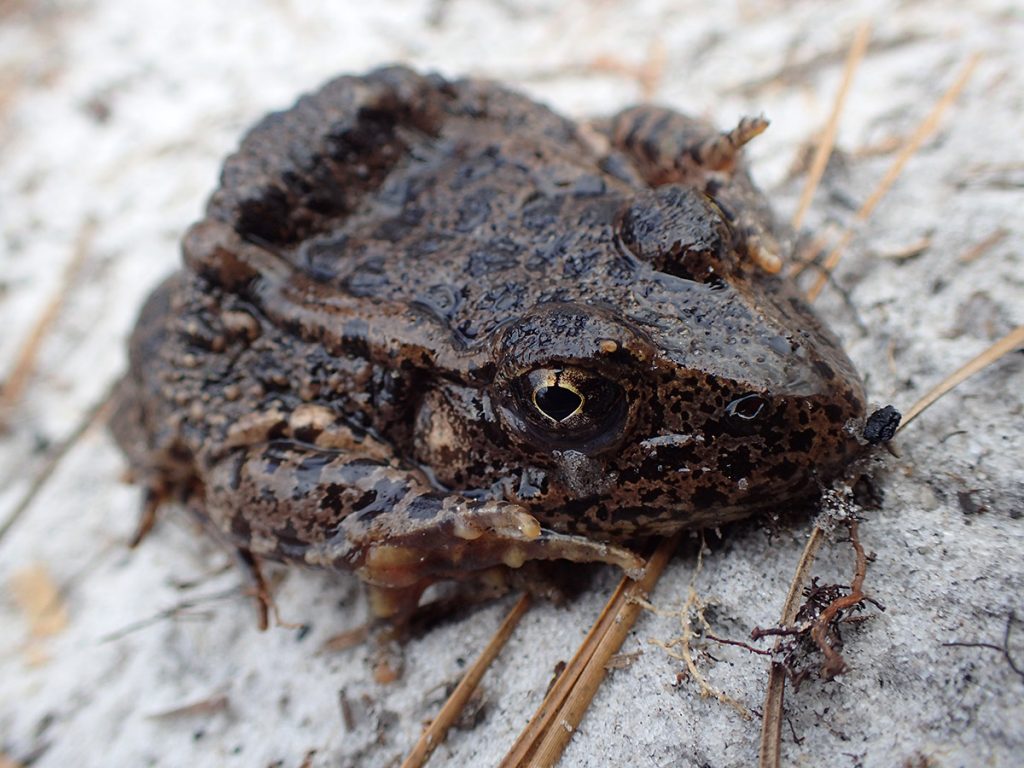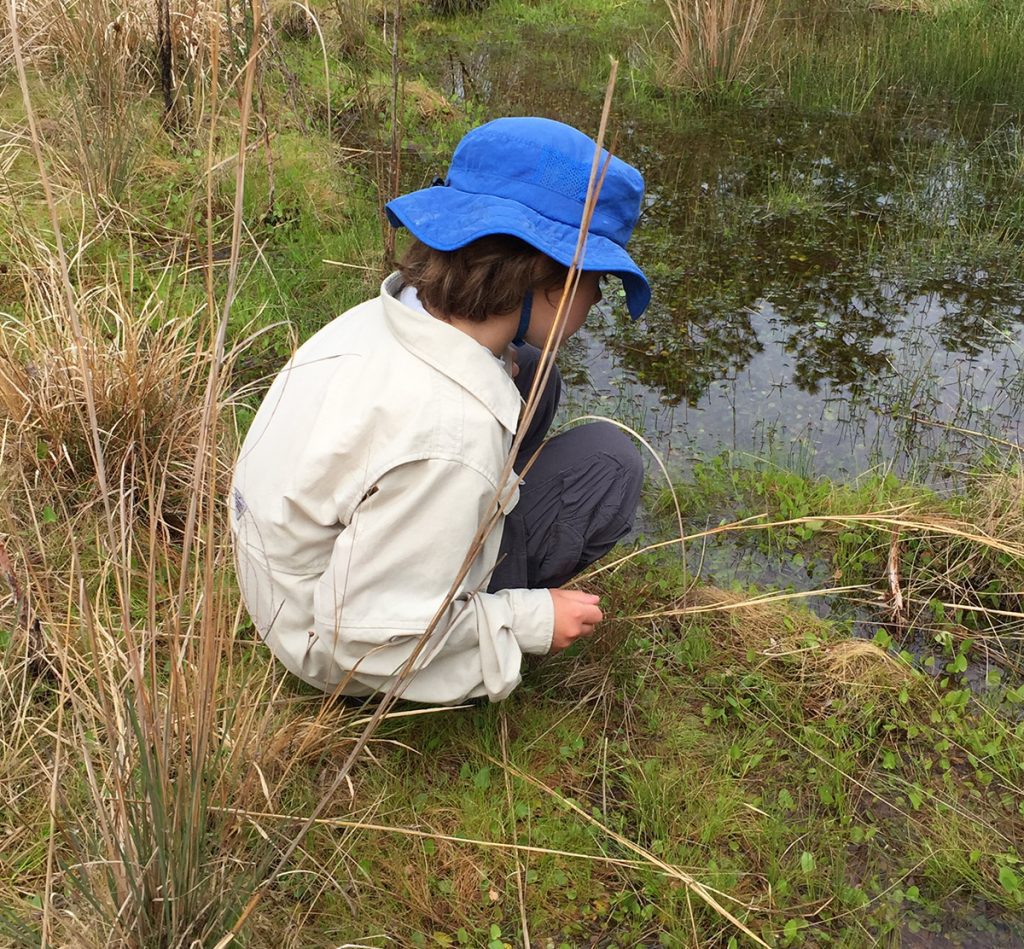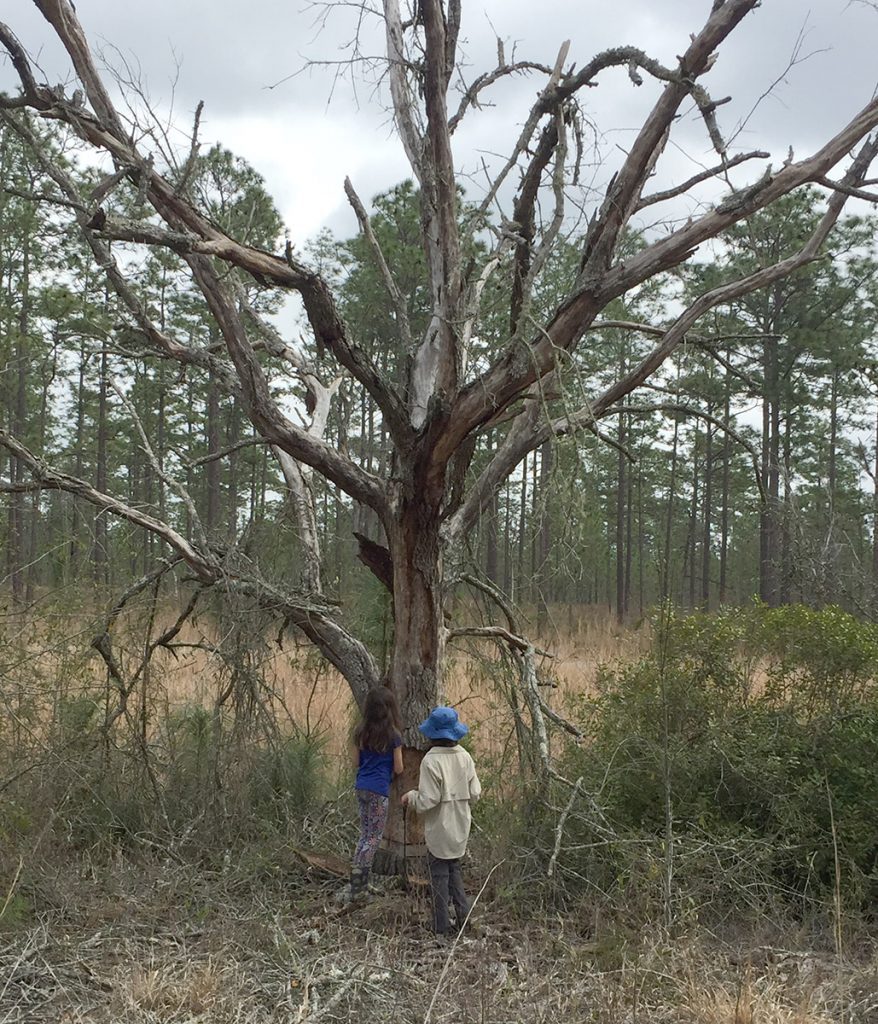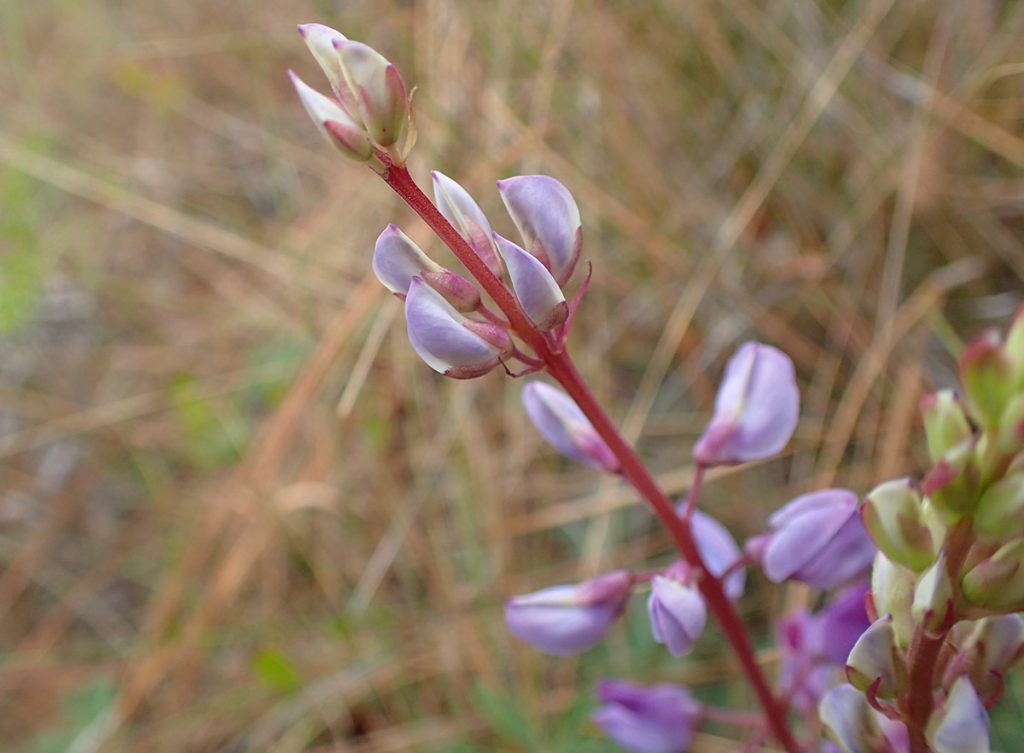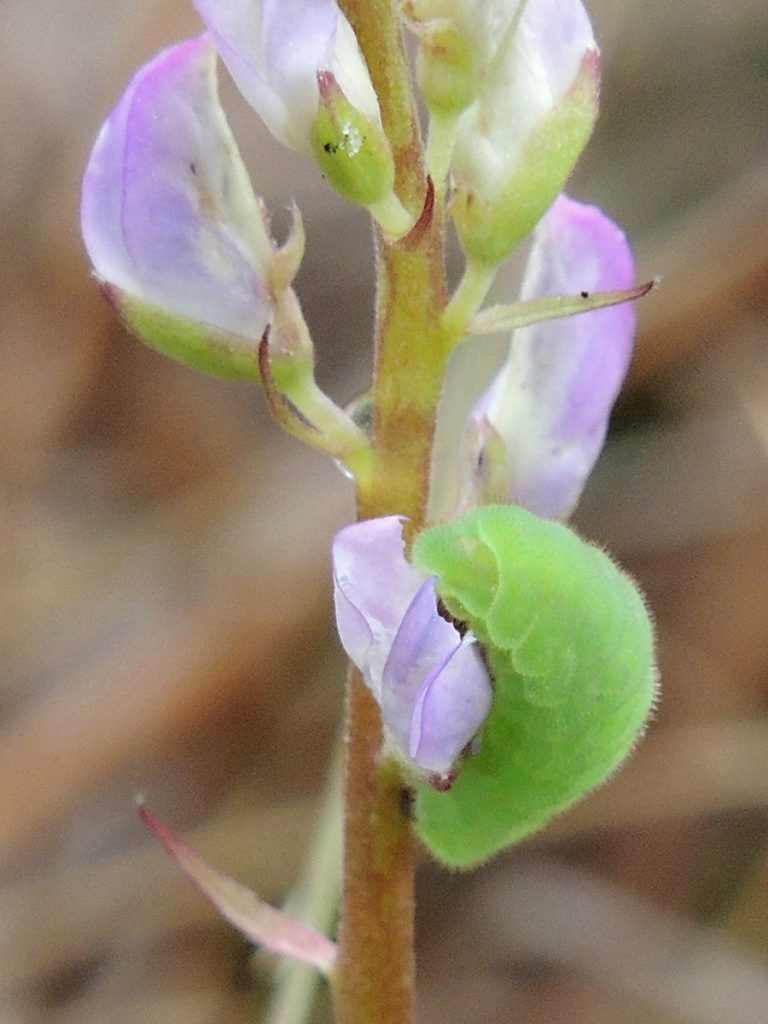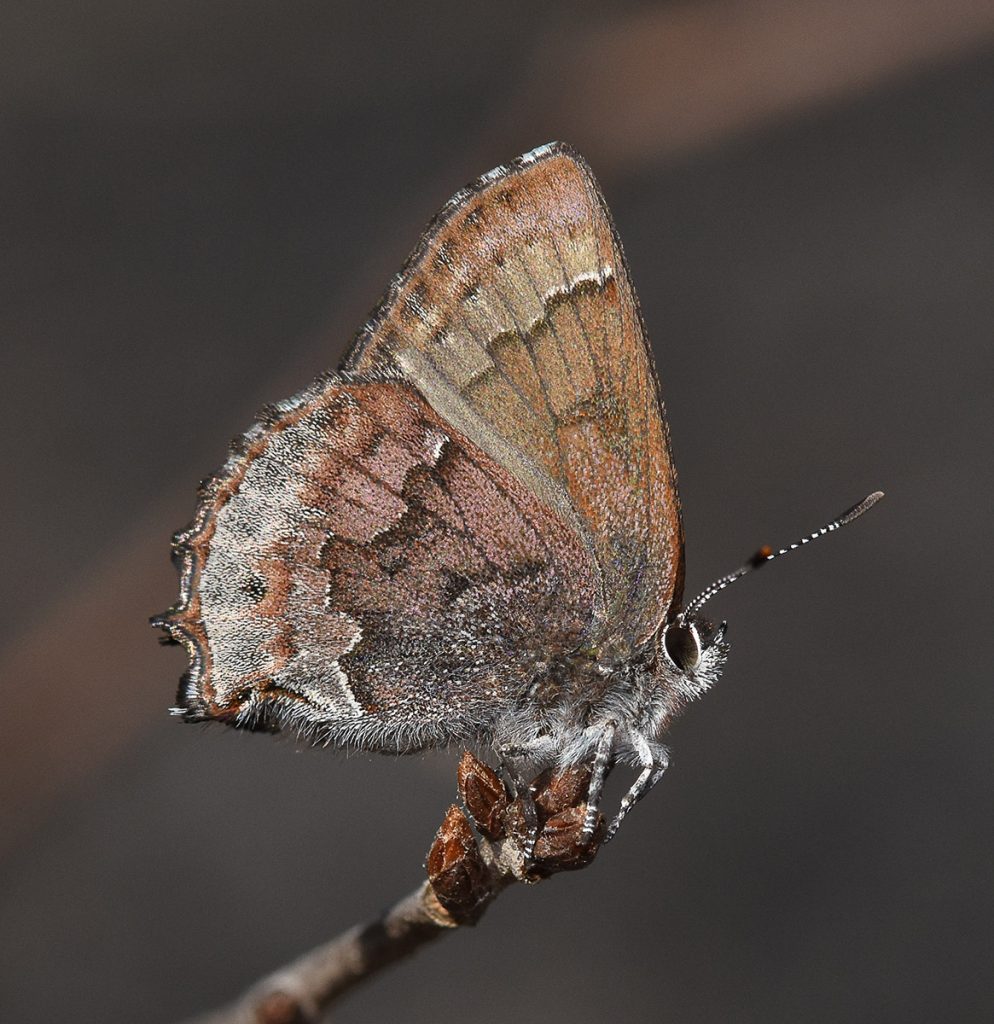Ephemeral wetlands in the Munson Sandhills are currently dry. But this region of the Apalachicola National Forest has plenty to see, including rare and threatened animal species.
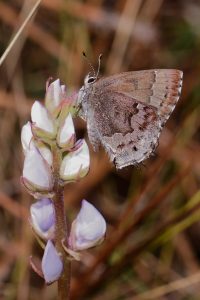
The frosted elfin is a rare butterfly whose strongest concentration in the Southeast is within the Apalachicola National Forest. Photo courtesy Dean and Sally Jue.
Rob Diaz de Villegas WFSU Public Media
Today, we’re taking the kids out to ephemeral wetlands in the Apalachicola National Forest. Our purpose? To show them that right now, the wetlands aren’t so wet.
It sounds like a crazy reason to drag kids out to the forest on a Sunday morning. Last year, we adopted two wetlands with two other families, my son Max’s first grade classmates. So they’ve already started learning about this environment and formed positive memories after spending time here with their friends.
We’re here today because there’s a tremendous value in visiting the same spot in nature over time, through different seasons and climate cycles. Nature isn’t static. Individual plants and animals change through the seasons. The wetland itself changes over the course of wet and dry years. Being here is the best way for kids (and adults) to get in tune with the workings of any wild space.
And even in its current dry state, we still have the opportunity to see some things. In particular, Max, his friend Dylan, and little brother Xavi might get to see the gopher frog, a species of concern.
At least, that’s what Rebecca Means is hoping. She oversees the Coastal Plains Institute’s Adopt an Ephemeral Wetland program. As participants in this program, we’d typically go out at least twice during the peak amphibian breeding season to net our wetlands, and record and report our findings.
That’s not happening this year, at least not yet. Rebecca has twice had to cancel training sessions with us because water levels in the wetland have been low for several months. This is normal. Ephemeral wetlands fill from below as the water table rises and falls, and when rainfall is low overall, the water table is lower. Even a good rain will drain through the wetland if the aquifer is empty enough.
“Despite all the recent rains, the Munson Sandhills remains quite dry.” Rebecca says. “Almost every ephemeral wetland in the approx. 35,000 acre region remained dry throughout the winter. The lack of significant rainfall means that the wetlands did not fill and very little winter-breeding took place among the special group of amphibians that depend on these types of wetlands.”
So no newt and frog larvae to see today. But since our training was cancelled, Rebecca offered to let the kids take part in another of CPI’s citizen science initiatives: checking their striped newt drift fences.
The current drought period has affected other local waterways as well. Check out this January story on Lake Miccosukee’s sinkholes becoming active, with geologist Harley Means.
A Google satellite image of the Munson Sandhills region of the Apalachicola National Forest. You can see the larger ponds in this image. If you zoom in and explore, you can find several dozen more.
Investigating the Striped Newt Pond Drift Fences
No, we’re not likely to find the endangered striped newt today.
This is an animal that was extirpated from the Apalachicola National Forest during a decade-plus drought. The Coastal Plains Institute has, for the last few years, been releasing male/ female pairs of newts into wetlands during their breeding season. Max participated in a release when he was four; you can learn more about the newts and the repatriation program by clicking to that story.
Currently, the striped newts here have morphed to breath air- losing their gills- and headed into the upland pine forest. But there’s still reason to check the wetlands. Striped newts are part of an ecosystem, and every plant and animal affects the other.
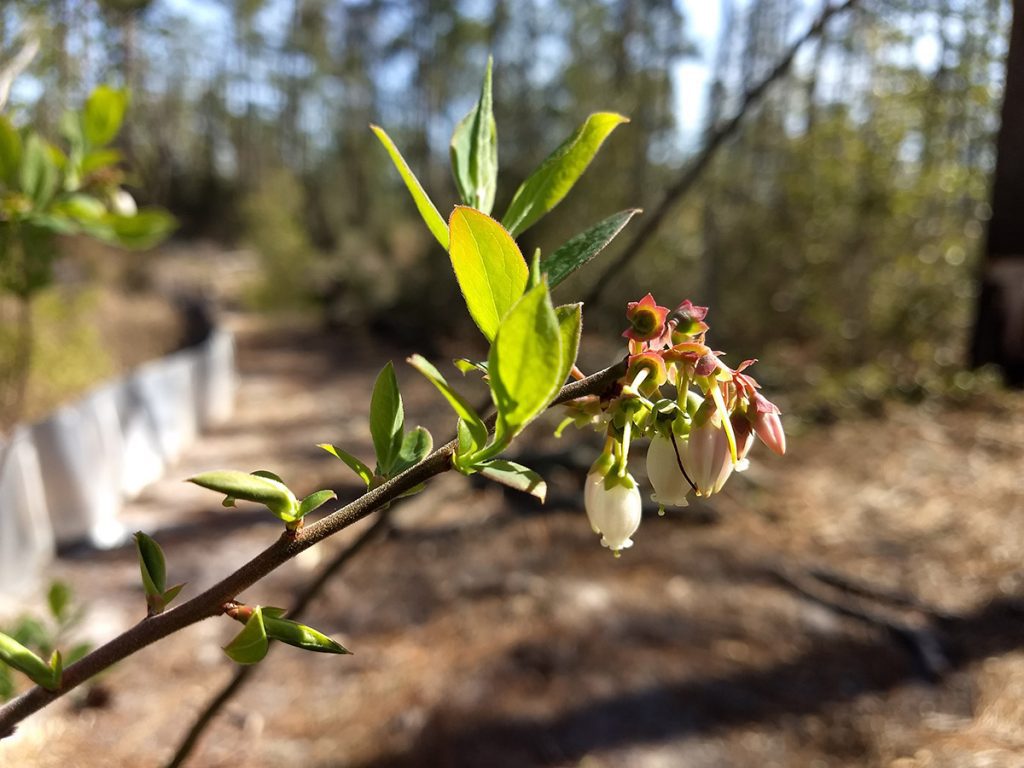
Blueberry bush by a striped newt repatriation pond drift fence. Photo credit: Rebecca Means, Coastal Plains Institute.
As we approach the pond we’re checking, we see flowering blueberry bushes. Rebecca, Ryan, and their volunteers will check these fences into the summer and beyond; when these blueberries are ripe in June, they’ll make a nice treat for someone working on a hot day.
Here’s how drift fences work. They encircle the entire wetland, so newts and other non-jumping or flying critters can’t get in or out. If these animals are trying to get into the wetland (perhaps to breed) or out into the uplands, they’ll keep trying to go there, walking along the fence to find the way in. Eventually, they’ll fall into a bucket filled with water and a sponge. Creatures that need to be wet stay in the water, the others rest on the sponge.
The Coastal Plains Institute checks the fences daily, or these critters are sitting ducks to their predators. Those found on the inside buckets were trying to leave the wetland, and those on the outside were trying to get in. So after we record our findings, the animals are placed where they were trying to go.
Our Finds: What Lives in a Wetland When It’s Dry?
We break into teams- Xavi and I are on the outside buckets, Max and Dylan on the inside. First, we remove the sponges. Carefully. Many of the sponges have these mean looking spiders on them.
After the sponges are out, we swish our nets twice in the cup- one big swish clockwise, and one counter. This is how we’d catch newts and some frogs.
Of course, some things are easily spotted in the bucket even before we net them. While every little spider and insect is important in this ecosystem, finding the cuter critters is a good way to keep the kids engaged.
This is an eastern mud turtle (Kinosternon subrubrum). It’s one of the many predators that threaten a striped newt within the wetland.
We also find a lot of smaller creepy crawlies that I find interesting. While spiders, such as the fishing spider, do eat striped newts, none of the species below are known newt predators (thanks to Rebecca Means for the IDs).
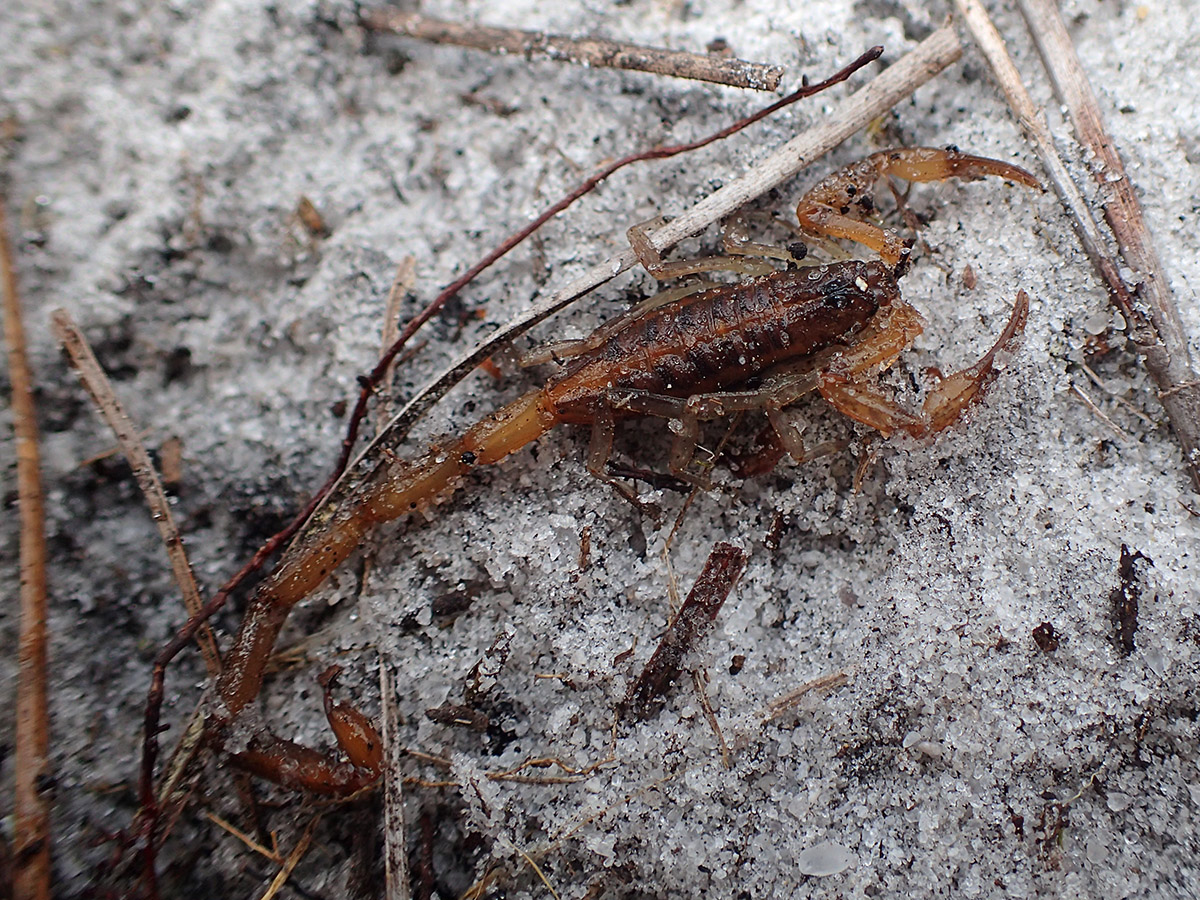
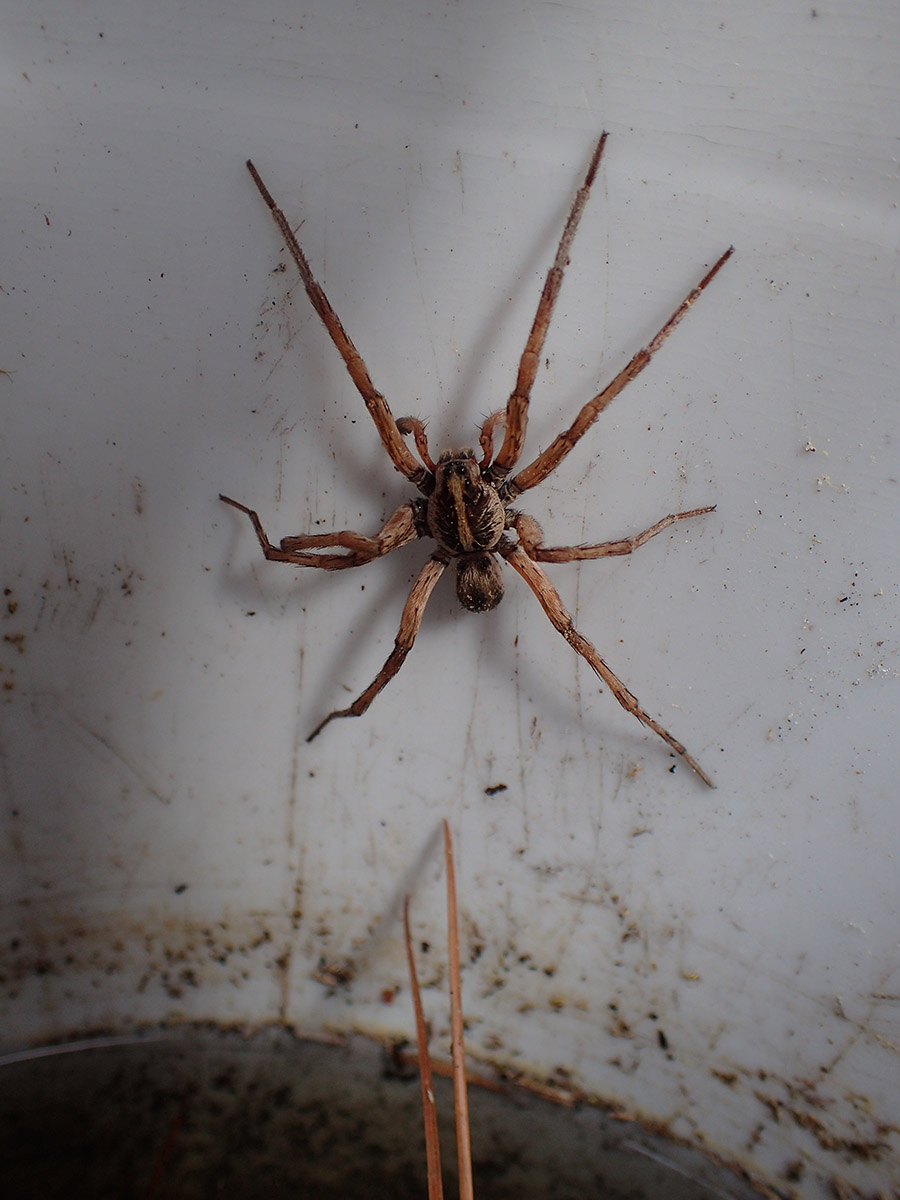
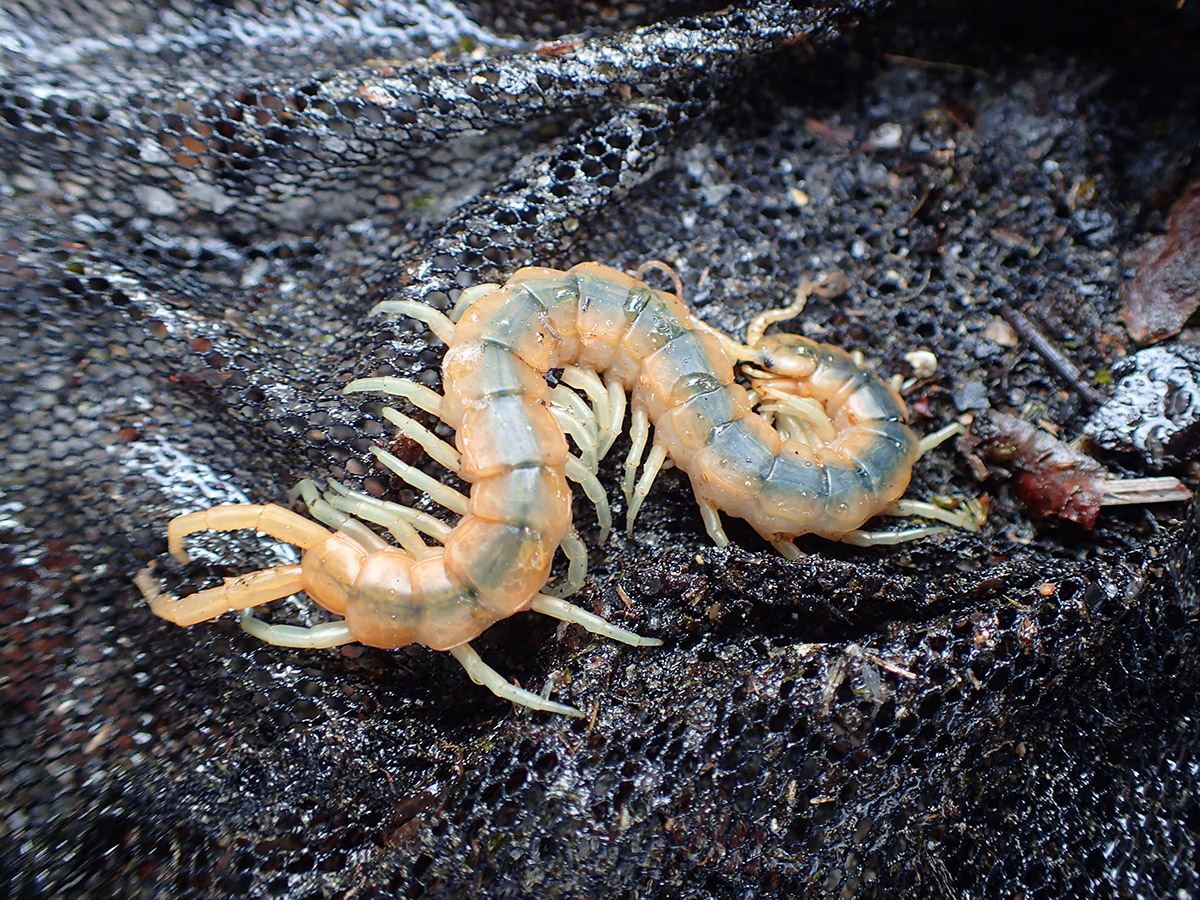
She doesn’t record these species. Rebecca says that this is a topic of conversation between she and Ryan around their dinner table. In how much detail do they need to know the species found next to the wetland? These species might not interact with the amphibians they’re tracking, but might they directly affect animals that eat or get eaten by the frogs and salamanders here?
These are the questions scientists wrestle with. In the end, I think, their daily visits to the wetland start to give them an idea of how all of these animals affect each other. It’s the same reason we keep bringing the kids here: the more you visit, the more you see.
And soon, we see the one animal Rebecca was hoping to see today.
Meet the Gopher Frog
On one of our last interior buckets, I find something large in my net. Aside from the small cricket frogs hopping away from our feet, this is the first amphibian we’ve seen today. And it’s a species of interest to Rebecca, and to ecologists statewide.
“Although it is no longer state listed,” Rebecca says, “it is still included in Florida’s Imperiled Species Management Plan. Primarily due to habitat destruction, the population of this species has declined throughout its range. The ANF has a relatively good population of gopher frogs but wetlands need to be hydrated in the winter/spring months, and stay hydrated for up to 6 or 7 months, for gopher frog reproduction to be successful.”
You can see here the gopher frog’s defensive pose. With the shape it takes and its coloration, it looks not unlike a rock. When Rebecca picks it up (see the banner image above), it puts it front feet over its face.
Our netting done, we walk into the wetland to see what water is left. It’s not entirely dry.
But it’s not enough water for CPI to release newts into.
“The striped newt breeds in ephemeral wetlands with hydroperiods greater than 5 or 6 months as their larvae take at least that long to mature and metamorphose.” Rebecca says. “To bring back populations of striped newts in the ANF, we release captive bred adult newts in wetlands during the winter/early spring months – their normal breeding season. Because of the dry winter, we were not able to release adult striped newts this year. We hope that recent and future rains hydrate area wetlands sufficiently such that we can safely release larval newts this late spring/summer.”
And while the wetlands naturally drain and refill, the striped newt is a species that needs a little extra help as it gets reestablished here. That’s why, as Rebecca explains to Dylan’s dad, Don, CPI has lined the newt ponds with a synthetic rubber called Ethylene Propylene Diene Monomer. They hired a tractor to clear the wetlands of vegetation, laid the rubber down, and piled the pond muck back over the rubber.
As Rebecca remembered, vegetation started growing back out of the muck within a few months. EPDM doesn’t hold water indefinitely, rather, it allows it to drain more slowly, and give newts a little extra time to breed.
Exploring the Forest with Friends
The kids start getting antsy as we check the last few buckets. When we’re done, it’s time to go exploring.
The forest is full of things to stimulate young curiosity. At school, Max and his friends are always coming up with games. They’ll come up with an outline of a story, choose their characters, and act it out in whatever space they’re in. Here, a creepy dead looking tree could be an evil castle, or a giant monster.
I often wonder how long they’d play if adults didn’t interrupt. But the grown ups want to explore, too. After all, the forest is full of things to see.
Butterfly Research in the Munson Sandhills
“Do you guys want to see a butterfly research site?” Rebecca asks.
We walk down the forest road away from the pond, but not very far. Here, some folks we work with from time to time are researching a rare species of butterfly known as the frosted elfin. For the last four springs, Dean Jue, Sally Jue, Dave McElveen, and Virginia Craig have been studying this critter here in the Munson Sandhills, which is home to the largest population in the southeastern United States.
Last summer, we joined this team on a Tallahassee-wide butterfly survey, which included a morning here in the Sandhills. We wouldn’t have see the frosted elfin then. “The Frosted Elfin (Callophrys irus) lives its entire life cycle in the forest,” Dean and Sally wrote to me, “but the adult butterfly is out only in late February through March and early April.”
So we’re out at the right time. Rebecca takes us to the elfin’s only larval food source, the sundial lupine. This is a relative of the gulf lupine we saw last year at St. Vincent Island and at the outflow of Deer Lake.
The flowers give us an easy way to spot the plant, but the leaves are equally important as a food source for the caterpillars.
Max and Dylan have raised butterflies at home and in school (mostly monarchs, but others as well), and so here’s a chance to see this at work in the wild. Unfortunately, we don’t see the butterfly today. And if I had talked to Dean and Sally before heading there, I might have known where to look for chrysalides: “Elfin larvae eat the lupine leaves and flowers and then pupate in the leaf litter or beneath the soil surface where they remain until the following spring.”
Not that I was going to dig up the area around the lupine.
Thankfully, Dean and Sally had some great frosted elfin photos to share. Here’s the caterpillar grazing on sundial lupine:
And here’s the adult:
Overall, they have 50 study sites in 11 different burn units of the Apalachicola National Forest. Their research has a similar focus to the research we covered in our first segment with them. They’re recording adult and larval sightings, and trying to determine what prescribed burning schedule is most compatible with the species.
Should the US Forest Service alter their fire regime for one tiny insect? Maybe. The thing to remember is that this butterfly is native of this forest. Since wild fires of old didn’t wipe out this species’ caterpillars or chrysalides, learning the most compatible fire schedule for the frosted elfin helps us to understand how fire had once burned naturally. And it stands to reason that mimicking historic fire patterns would produce the best ecological benefits for all species adapted to live in this forest.
Biodiversity in the Apalachicola National Forest
At 632,890 acres, the Apalachicola National Forest is Florida’s largest National Forest. Much like the frosted elfin, there are many other rare and endangered species that are more abundant here than anywhere else, like the red cockaded woodpecker. And as we learned last summer, the southern dusky salamander is disappearing from its range, but seems to be staying strong in the Forest’s Bradwell Bay Wilderness. While habitat loss affects many vulnerable plant and animal species, here at least they have space to exit relatively undisturbed.
The kids are maybe a little young to appreciate the fact that they’re in a robust, biodiverse ecosystem. But they definitely like seeing critters, splashing around in wetlands, and the wide open play space it presents. As adults, will they value the part of this where they participated in citizen science and spent time in the field with scientists? I know I value that I get to do that in my job. But only time will tell how this aspect “benefitted” them.
At the very least, they’re enjoying their time in the forest. And if this isn’t a place they can enjoy, it’ll never be a place they want to learn about.
Next week on Local Routes, we get to learn about some critters in the forest that maybe aren’t as cute as newts or frogs. We’re going beneath the surface with Dr. Walter Tschinkle, who has been making metal castings of ant nests in the Apalachicola National Forest. He studies here because of what he calls an unusually dense concentration of Florida harvester ants in the forest (sound familiar?). He currently has an exhibit at the Tallahassee Museum, and you might be surprised how deep ants burrow, or how complex some species’ nests are. Look for that on Thursday, May 17 at 8 pm ET on WFSU-TV.

After a picnic in the forest, the kids snuck into our car. They look about ready for a road trip through the forest, don’t they?


